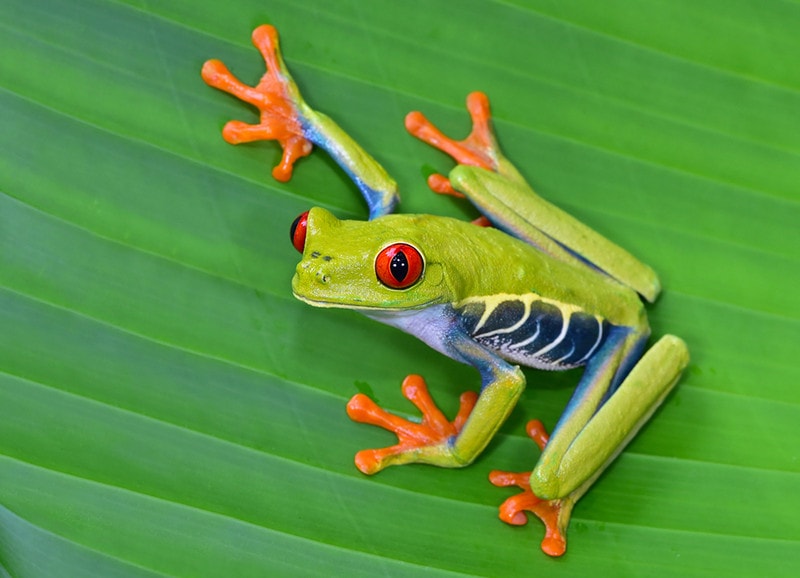Can You Keep a Wild Frog as a Pet? Vet Reviewed Facts & Advice

Updated on

Frogs are fascinating little animals. They have existed for more than 200 million years and were around at the time of the dinosaurs. Some species can grow as large as 15 inches or as small as half an inch. And, in captivity, some species of frog can even live as long as 20 years. With more than 6,000 species of frogs across the world, it is easy to be fascinated by these little amphibian creatures, which can lead some people to want to keep them as pets.
While some frogs do make good pets, it is generally recommended that people do not try and keep wild frogs as pets. Doing so can be dangerous for you or the frog. Some are also very challenging to keep alive with a variety of species not recommended to be kept as pets, at all.
Can You Keep a Wild Frog?
It is recommended that wild frogs not be kept as pets for several reasons. Firstly, some species are highly poisonous. The Golden Poison Dart Frog, for example, is considered one of the most poisonous creatures on the planet. A single frog can produce enough poison to kill 10 adult humans, although this species is sadly under threat in the wild. Most poisonous frogs indeed lose their poison when in captivity because of a change in diet, but this takes time and there is never any guarantee that one will be completely safe to touch.
Some species are endangered and protected under local law so it may actually be illegal for you to capture them, depending on where you live and the species of frog.
Different species also have very different needs in terms of the right diet, environment, temperature etc. It can be very difficult to identify the species that you have caught, and provide them with their very specific needs to remain happy and healthy in captivity. Although captive-bred variants can be kept successfully as pets, tree frogs are notoriously difficult to care for. They require a lot of vertical space and the frogs themselves are very fragile, which means that it is too easy to kill them when trying to handle them or even moving things around in the terrarium.
Finally most wild frogs, as well as all wild amphibians and reptiles, carry salmonella as well as other harmful pathogens. Salmonella is especially dangerous for pregnant mothers as well as young and old people.

Frogs As Pets
Interested potential owners should consider getting a captive-bred frog, rather than trying to house a wild one. Frogs can make good pets, with some of the easier species even making good first pets. With that said, owners do need to provide adequate housing and need to meet the frog’s other requirements, including feeding and cleaning out the terrarium.
Top 4 Frog Species for Beginners
Although they will never really truly enjoy being held and petted, some species will, at least, tolerate being handled. Below are four of the best frog species for beginners to consider:
1. White’s Tree Frog

The White’s Tree Frog is a decent-sized frog that will grow to around 3 inches long and quite wide. There are reports of White’s Tree Frogs living up to 20 years in captivity, although 7 or 8 years is a more likely lifespan, but their desire for a temperature of around 28°C means that you will need a heat lamp in a basking area. This docile species may tolerate being handled, although no frog will ever truly enjoy being handled and petted.
2. Oriental Fire-Bellied Toads

There are a lot of plus points to the Oriental Fire-Bellied Toad. It is green and orange in color, so it has the look of an exotic species. Despite its name and small tubercles covering its skin, they are technically a frog and not a true toad. It will live as long as a White’s Tree Frog when given good care although not completely diurnal, it is somewhat active during the day, so owners get to enjoy watching their frog while it’s awake. However, the Oriental Fire-Bellied Toad is a semi-aquatic frog, so it will need a terrarium to match its requirements.
3. Red-Eye Tree Frog

As the name suggests, the Red Eye Tree Frog has bright red eyes. When combined with its lime green skin, it makes the frogs easy to spot and gives them a certain character. This is quite a small species, at just over 2 inches, and the small size of the frog means that it is quite a fragile little frog and one that is best enjoyed from the other side of a tank. Keep handling to a minimum.
4. Tomato Frog

The Tomato Frog is a great first frog. They’re quite large, red, and round, like a tomato. They won’t usually hop a mile when you open the enclosure to clean, and their size means that they can tolerate handling better than some other species. The Tomato Frog is nocturnal, so don’t expect to see too much activity in the tank during daylight hours.
- Related Read: Are Frogs Nocturnal?
 Conclusion
Conclusion
Frogs can make very good pets, and with more than 6,000 different species around the world, there is certainly a good range to choose from. Although it can seem tempting to grab any frog that hops by and call it your own, it is generally recommended not to keep wild frogs as pets. Some are poisonous and potentially very dangerous. Some are difficult to care for effectively, and all carry some forms of bacteria that could make you ill.
Featured Image Credit to: Couleur, Pixabay











